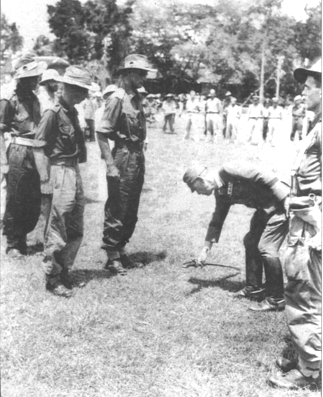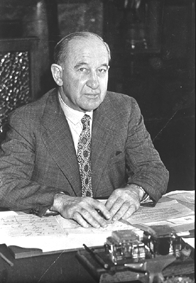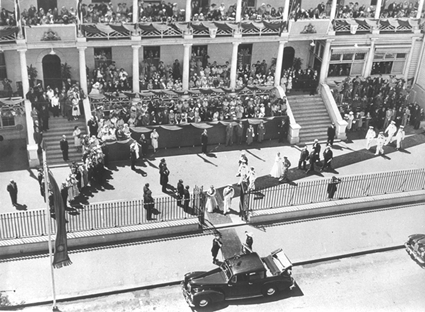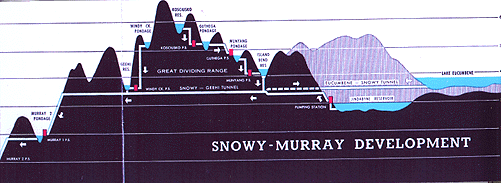Parliament and World War II
 Lt-Colonel Robson, Member for Vaucluse in the Parliament of New South Wales, takes the Japanese surrender at Bandjermasin, Borneo
Lt-Colonel Robson, Member for Vaucluse in the Parliament of New South Wales, takes the Japanese surrender at Bandjermasin, Borneo
In September 1939, Bertram Stevens was deposed as Premier of New South Wales by Alexander Mair. The United Australia Party – United Country Party coalition Government had begun to show its internal strains. In the same month the Labor Parties, still split as a result of the Lang Government crisis that had led to its dismissal in 1932, dumped Jack Lang as Leader of the Opposition and replaced him with the far less controversial William McKell. Also in September 1939, Australia entered World War II.
In the months prior to the war, economic conditions had begun to worsen again in New South Wales after a period of recovery from the 1930s Depression. Wartime production and prosperity soon began to reverse this. The government focussed on the war effort and put many state programs on hold, but McKell argued that the war was primarily a Federal responsibility and that state services should be maintained. At the elections in May, 1941, the UAP vote collapsed and the Labor Party was returned to office with a strong majority to begin an unprecedented quarter century in power.
By 1942 with the nation facing an unprecedented war emergency, the Commonwealth government began assuming far greater powers, including the vital power of collecting income tax, formerly collected by the states. This alone was enough to ensure increased future Commonwealth domination of the federal system.
During the war years, more than 130 members and future members of the Parliament of New South Wales served in the Australian military forces. Some remained serving members whilst in the military forces. Of the many stories, two examples follow. Stanley Stephens, serving in the Middle East in the 9th Division of the AIF, was blinded at the Battle of El Alamein. Invalided back to Australia, Stephens turned to politics as a new career and was elected Member for Byron in 1944, a seat which he retained until 1973. Stephen was Minister for Housing and Cooperative Societies in the Liberal-National Party Government from 1965 until his retirement.
Ewan Robson was elected as an Independent United Australia Party candidate for Vaucluse in 1936, a seat which he held until his resignation in 1957. Robson joined the AIF in 1939, becoming Lt-Colonel commanding the 2/31st Battalion. On 9 September, 1945, he took the Japanese surrender at Bandjermasin in Borneo. His battalion had taken heavy casualties in recent weeks and Robson was in no mood for magnanimity. When the Japanese commander, Major General Uno, attempted to hand over his sword at the ceremony, Robson had his interpreter instruct the General to lay it at his feet. General Uno was mortified and the interpreter was seriously concerned that Uno would commit suicide on the spot. The General eventually complied with the instruction. One of Robson’s sergeants present at the surrender was Robin Askin, who would eventually break the 25 year Labor domination of state government to become Premier of NSW in 196 5.
A Quarter Century of Labor Governments
 William McKell, the Labor Premier who, in 1947, became Governor-General of Australia
William McKell, the Labor Premier who, in 1947, became Governor-General of Australia
From McKell’s victory in 1941 until the Liberal-National Party Coalition led by Robin Askin won the 1965 election, the Australian Labor Party held office in New South Wales without interruption.
After a period of sound and moderate social reform, McKell resigned to be appointed Governor General of Australia in 1947. The Premiers that followed were: James McGirr (1947-52); John Joseph Cahill (1952 to 1959 when he died in office); Robert Heffron (1959-64); and John Renshaw (1964-65). At first there was a great focus on planning, provision of major public works such as dams and power stations, and public housing, Part of the problem of this long period became that, with ample time to undertake most of the party programs, by the mid-1950s the Government was being accused of running out of ideas. The Federal Prime Minister, Robert Menzies (1949-66), successfully exploited Cold War concerns about Communists to undermine his Federal Labor opponents and the Labor Party was confronted with the emergence of the anti-Communist Democratic Labor Party (DLP. However, in NSW the DLP had less impact on the New South Wales Labor Party than it did nationally and in some other states.
The Labor government’s steady but unexciting progress had some highlights, such as the start to the Sydney Opera House but even leadership changes did little to infuse new blood. There was developing an increasing sense that the real focus of events was elsewhere – in Canberra and the world beyond – and that New South Wales politics had less vitality or relevance.
During this period, Parliament House itself reflected this lack of vitality. Minimal maintenance and plain public works coats of paint kept it inadequate for the needs of members and staff and utilitarian looking. Towards the end of this period some grand proposals to raze the ‘government side’ of Macquarie street and construct modern tower blocks and legislative facilities were, fortunately, not adopted.
Post-War Development and Social Change
 1954: Queen Elizabeth II - the first reigning monarch to visit Australia - and Prince Phillip, depart from Parliament House, Macquarie Street, Sydney, amidst great pomp, ceremony and enthusiasm
1954: Queen Elizabeth II - the first reigning monarch to visit Australia - and Prince Phillip, depart from Parliament House, Macquarie Street, Sydney, amidst great pomp, ceremony and enthusiasm
The period after WWII was distinguished by a “long boom” of prosperity and full employment, rising living standards, large scale migration (mainly from Europe), continued dependence on agriculture but with a greatly expanded manufacturing industry, an explosion of domestic consumer expenditure and private motor vehicles, some major public works such as the enormous Commonwealth-funded Snowy Mountains hydroelectricity Scheme, urban growth and large-scale housing development. However, in this period of rapid growth, despite substantial public works programs, provision of services such as electricity generation, roads, public transport, sewerage, schools and health services inevitably lagged behind demand.
By the early 1960s the “long boom” was flattening out. Unemployment and inflation increased enough to cause disquiet. The “Lucky Country” was beginning to face more challenges than it had in the relatively easy boomtimes of the 1950s.
Socially, the face of New South Wales was changing in every sense, as migration began to alter the sounds, look and character of urban Australia. However, social policy also lagged behind this change with relatively little recognition of or provision for the increasingly multicultural character of the state. But the old Anglo-Celtic character and traditional values and prejudices were losing their hold; women were entering the workforce in increased numbers; university and tertiary education were becoming available for more than the privileged; television, modern communications and international travel were also contributing to a growing cosmopolitan awareness; a new Americanised youth culture was emerging; and new, less complacent attitudes were appearing. especially amongst the educated young.
Increasing Commonwealth Power
World War II had delivered greatly increased powers to the Commonwealth government including a take over of income taxation (‘as an emergency wartime measure’). The post-war national Labor Government had attempted to use its wartime powers to further increase Commonwealth leadership and expand socialist programs and nationalisation. With Labor’s defeat nationally in 1949, Australian national politics of the 1950s and into the ‘60s were defined for the most part by the Liberal-Country Party coalition dominated by Prime Minister Robert Menzies until his retirement in 1966. The New South Wales Labor state government, and indeed the governments of all states, expressed increasing acrimony against Commonwealth decisions and control of the purse-strings which they felt undercut state programs. Nevertheless the Commonwealth which had taken responsibility for social services along with income tax powers, continued to use its financial domination to strongly influence more and more state areas of responsibility as universities and education, health and public works.
In addition, the Canberra and the Australia of the post-war period were very different from those of the pre-war world. From a sheep paddock with a scattering of houses and a temporary Parliament House, Canberra was rapidly evolving into a showpiece national capital, and Australia, no longer riding on Britain’s back in foreign affairs and trade, was playing a more significant and independent role in the world. Despite Prime Minister Menzies’ avowed pro-British sentiments, Australia was more aligned politically with American affairs and economically with Japanese. The attentions of Australians moved more towards the national government than the state. One writer commented on the period; “Macquarie Street was a sideshow in the great carnival of Australian politics, an old-established and honourable one to be sure, but away from the big ring and the attention of the crowds”.

The Snowy Mountains Hydroelectricity Scheme had its origins in the New South Wales Parliament but got underway in 1949 as the Commonwealth Government's flagship capital works program. It attracted thousands of migrant workers and created massive dams and power stations amidst Australia's highest mountian range.
